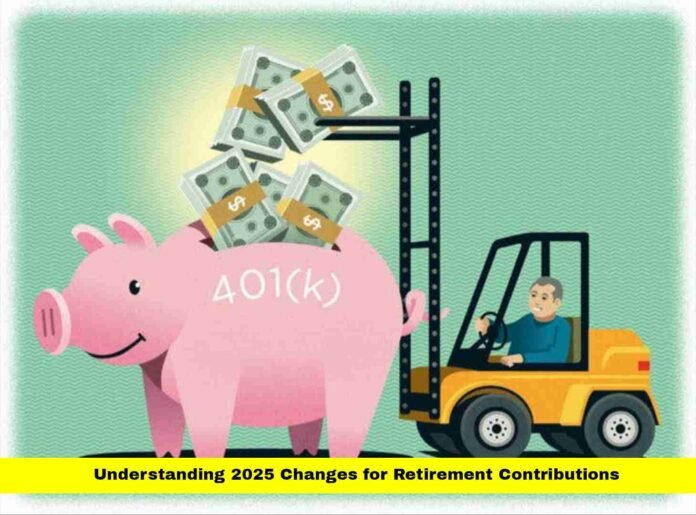The 2025 catch up contribution 401k rules have changed significantly under SECURE 2.0, giving employees aged 60–63 a new, higher “super catch-up” limit. For 2025, this means a standard catch-up of $7,500 for those 50 and over, and up to $11,250 for the 60–63 age group — if their plan allows it.
2025 Contribution Limits in Detail
- The standard elective deferral limit for 401(k) plans in 2025 is $23,500.
- Employees aged 50 and above can contribute an additional $7,500 as a catch-up.
- Workers aged 60, 61, 62 or 63 may be eligible for a larger “super catch-up” contribution of $11,250, raising their total possible deferral to $34,750, if their employer’s plan offers that feature.
Who Qualifies for the Super Catch-Up in 2025
Not everyone over 60 is automatically eligible. To use the higher “super catch-up” limit:
- You must be age 60–63 at some point during the calendar year.
- Your employer’s 401(k) plan must permit this super catch-up option. It’s not mandatory for all plans.
- The feature is optional, meaning some employers have opted in while others haven’t.
Tax Treatment: Traditional vs. Roth Catch-Up
- You can generally choose whether your catch-up contributions are pre-tax (traditional) or Roth (after-tax), depending on what your plan supports.
- However, for certain high-earning workers, SECURE 2.0 introduces a mandatory Roth catch-up requirement starting soon. In such cases, catch-up contributions must be made as Roth contributions rather than pre-tax.
Why This Change Matters
- The larger catch-up for ages 60–63 is designed for people who are still working but want to ramp up their retirement savings in their highest-earning years.
- It’s especially helpful for those who may have started saving later or want to aggressively boost their 401(k) in the final working stretch.
Practical Steps for Maximizing Your 2025 Catch-Up
- Check your plan — Confirm with your HR department or plan administrator whether your 401(k) allows the higher super catch-up.
- Adjust payroll — Make sure your payroll elections reflect the extra catch-up contributions. Waiting until December may limit your ability to contribute fully.
- Decide pre-tax vs Roth — Consider your tax situation now vs. retirement. Roth contributions grow tax-free and can offer diversification, but pre-tax gives you a tax break now.
- Coordinate across jobs — If you switch employers in 2025 or have multiple plans, keep track of total contributions so you don’t exceed limits.
- Plan for future changes — Be aware of the mandatory Roth catch-up rule for high earners coming soon; it can affect your contribution strategy.
Potential Challenges and Pitfalls
- Optional nature of the super catch-up: Since not all employers adopt it, just because you’re age-eligible doesn’t guarantee you can contribute the full $11,250.
- Payroll system constraints: Some payroll systems may not yet support the higher catch-up election, or may default to older limits.
- Mandatory Roth risk: If you qualify as a “high earner” under SECURE 2.0 rules, your future catch-up contributions could be forced into Roth, which means paying tax now.
- Overcontribution risk: If you’re contributing to multiple retirement plans in a year (for example, you changed jobs), you might unintentionally exceed allowable limits.
Is the Super Catch-Up Feature Widely Adopted Yet?
- Because the enhanced limit is optional, adoption depends on the plan sponsor. Some employers may have already amended their plan documents to allow it; others may not plan to do so by the required deadline.
- Participants should be proactive: talk to HR, ask whether their plan supports the super catch-up, and request plan documentation or a summary of changes for 2025.
Long-Term Considerations
- As SECURE 2.0 evolves, retirees and near-retirees should revisit their deferral strategy every year.
- Changes in tax law could shift what makes sense for catch-up contributions (pre-tax vs Roth) depending on your income, tax bracket, and retirement timeline.
- For high earners, understanding the impending mandatory Roth catch-up rule is essential — it may dramatically affect your retirement tax planning.
Bottom Line
The 2025 catch up contribution 401k changes mark a meaningful opportunity for workers aged 60–63, if their employer plan supports the feature. By contributing up to $11,250 more than before, eligible savers can supercharge their retirement nest egg. But success requires knowing your plan’s rules, actively making the right payroll choices, and aligning your tax strategy.
Curious whether your 401(k) plan supports the 2025 super catch-up — or how to put it to work for you? Ask your HR or retirement administrator today.
